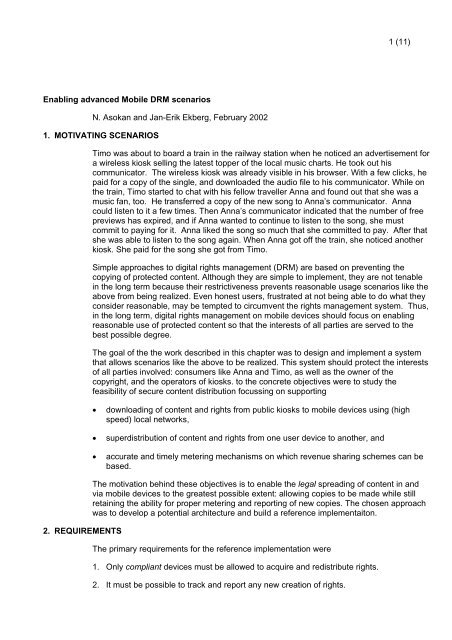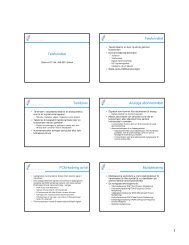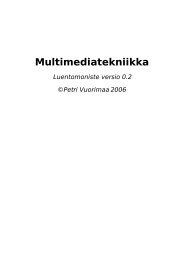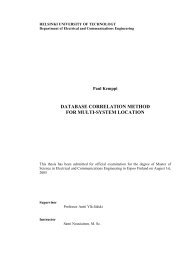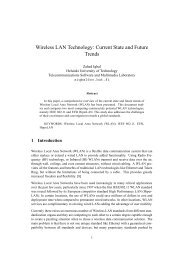Nokia Standard Document Template - TML
Nokia Standard Document Template - TML
Nokia Standard Document Template - TML
Create successful ePaper yourself
Turn your PDF publications into a flip-book with our unique Google optimized e-Paper software.
Enabling advanced Mobile DRM scenarios<br />
N. Asokan and Jan-Erik Ekberg, February 2002<br />
1. MOTIVATING SCENARIOS<br />
2. REQUIREMENTS<br />
1 (11)<br />
Timo was about to board a train in the railway station when he noticed an advertisement for<br />
a wireless kiosk selling the latest topper of the local music charts. He took out his<br />
communicator. The wireless kiosk was already visible in his browser. With a few clicks, he<br />
paid for a copy of the single, and downloaded the audio file to his communicator. While on<br />
the train, Timo started to chat with his fellow traveller Anna and found out that she was a<br />
music fan, too. He transferred a copy of the new song to Anna’s communicator. Anna<br />
could listen to it a few times. Then Anna’s communicator indicated that the number of free<br />
previews has expired, and if Anna wanted to continue to listen to the song, she must<br />
commit to paying for it. Anna liked the song so much that she committed to pay. After that<br />
she was able to listen to the song again. When Anna got off the train, she noticed another<br />
kiosk. She paid for the song she got from Timo.<br />
Simple approaches to digital rights management (DRM) are based on preventing the<br />
copying of protected content. Although they are simple to implement, they are not tenable<br />
in the long term because their restrictiveness prevents reasonable usage scenarios like the<br />
above from being realized. Even honest users, frustrated at not being able to do what they<br />
consider reasonable, may be tempted to circumvent the rights management system. Thus,<br />
in the long term, digital rights management on mobile devices should focus on enabling<br />
reasonable use of protected content so that the interests of all parties are served to the<br />
best possible degree.<br />
The goal of the the work described in this chapter was to design and implement a system<br />
that allows scenarios like the above to be realized. This system should protect the interests<br />
of all parties involved: consumers like Anna and Timo, as well as the owner of the<br />
copyright, and the operators of kiosks. to the concrete objectives were to study the<br />
feasibility of secure content distribution focussing on supporting<br />
• downloading of content and rights from public kiosks to mobile devices using (high<br />
speed) local networks,<br />
• superdistribution of content and rights from one user device to another, and<br />
• accurate and timely metering mechanisms on which revenue sharing schemes can be<br />
based.<br />
The motivation behind these objectives is to enable the legal spreading of content in and<br />
via mobile devices to the greatest possible extent: allowing copies to be made while still<br />
retaining the ability for proper metering and reporting of new copies. The chosen approach<br />
was to develop a potential architecture and build a reference implementaiton.<br />
The primary requirements for the reference implementation were<br />
1. Only compliant devices must be allowed to acquire and redistribute rights.<br />
2. It must be possible to track and report any new creation of rights.
3. Creation and transfer of rights must be possible even when there is no on-line<br />
connection to a network server.<br />
2 (11)<br />
4. When rights are exchanged for payment, it must be possible to use any payment<br />
scheme, both electronic and traditional. The system must not be limited to one or a few<br />
schemes only.<br />
The first requirement is applicable to any DRM system based on the notion of compliant<br />
devices. The last requirement is required for flexibility and is also generally applicable.<br />
Requirement 2 is necessary for the distribution of rights. This can be easily solved if there<br />
is always a connection to an on-line server. But this may not always be possible for mobile<br />
users. Requirement 3 captures this aspect. Requirements 2 and 3 can therefore be seen<br />
as specific to DRM for mobile users/devices.<br />
3. BASIC CONCEPTS AND DESIGN<br />
The architecture of a node is shown in the figure below. Each user node is required to have<br />
at least the following two parts:<br />
• A tamper-resistant module (called the DRM device)<br />
• A protocol engine implementing the rights transfer protocols (including a user interface)<br />
The reason for separating these two parts is the underlying trust assumption: the node is<br />
responsible for protecting the interests not only of the owner, but also of other parties such<br />
as the authors and publishers of content. This part of the node must be certifiable. It is<br />
therefore useful to identify the minimal certifiable functionality as a separate part. This is the<br />
DRM device. This separation also allows the DRM device to be used with different protcol<br />
engines, possibly implementing the rights transfer protocols over different transports. The<br />
implementation of DRM functionality requires some support from the underlying operating<br />
platform. This functionality is defined by the platform API.<br />
In addition, there may be additional entities such as<br />
• Rendering applications that receive content from the DRM device and render it, and<br />
• Authorization plug-ins (e.g., for a payment system)
3.1 Securing rights transfer<br />
Rendering Application Protocol Engine<br />
Usage API Rights Management API Access Control API<br />
DRM device/module Authorization plug-ins<br />
(payment, …)<br />
Platform API<br />
Operating platform<br />
Figure 1 Conceptual architecture of a node<br />
3 (11)<br />
A compliant device is one that behaves according to the specifications laid out here. Every<br />
compliant device will have an encryption key pair and a digital signature key pair for<br />
suitable asymmetric cryptographic schemes. Each device will also have a device certificate<br />
issued by the device manufacturer. The device certificate certifies the public keys of the<br />
device as belonging to a compliant device. Every device will also have the public signature<br />
verification key of the device manufacturer so that it can verify device certificates of other<br />
devices. For the sake of simplicity, let us only consider a single manufacturer. But devices<br />
of multiple manufacturers can inter-operate by using certificate chains and crosscertification<br />
of manufacturers.<br />
A piece of content is associated with two types of rights: usage rights which specify policies<br />
governing the local use of content, and transfer rights which specify policies for creating<br />
new rights for another device. The design supported several types of transfers including:<br />
• ‘give’: a device can give away its rights to a content to another device. Once the<br />
right is transferred, the sending device will not be able to use the content anymore.<br />
Note that the receiving device may pay the sender. Such sales are not the concern of<br />
the rights management system.<br />
• ‘copy’: copying creates a new right. This is used when content is sold by a kiosk or<br />
superdistributed by ordinary users.<br />
Rights for a piece of content are embodied in a voucher. Each piece of content is encrypted<br />
with a content key using a symmetric cipher. The voucher contains the content key<br />
encrypted using the public key of the target device. It also contains policies specifying how<br />
this copy of the content is to be used. Compliant devices will obey the policy restrictions<br />
specified in a voucher. When a right is transferred, the sending device creates a voucher<br />
targeted for the receiving device. A sending device MUST verify that the receiving device is<br />
a compliant device before creating a voucher for it. A receiving device will accept a voucher<br />
if it can verify its correctness: A voucher contains, among other things,<br />
• description of the content
• description of rights<br />
• content key encrypted using the public encryption key of the receiver<br />
• sequence numbers used to ensure freshness<br />
4 (11)<br />
• a message authentication code (MAC) on all of the other fields, using the content key<br />
When a compliant receiving device is asked to import a voucher, it verifies the validity of<br />
the voucher by first extracting the content key, and then checking the MAC. With these<br />
mechanisms, the Requirement 1 is met.<br />
Typically, verifying compliance alone is not enough for a sender to make an access control<br />
decision about a receiver. For example, in the case of a sale, the sender may ask the<br />
receiver to securely bind his device certificate to a payment transaction (e.g., open a<br />
secure channel, and send credit card number and device certificate through the same<br />
channel). To enable such access control decisions, other authorization certificates may be<br />
used. For example, a user may issue certificates to each of his devices so that they can<br />
recognize each other. A device can then automatically approve a ‘give’ transfer if the<br />
request came from another device belonging to the same user.<br />
3.2 Metering and reporting new rights<br />
Requirements 2 and 3 deal with distribution of rights by copying. Creation of a new right for<br />
a piece of content must be metered and reported so that the resulting revenue can be<br />
effectively collected and shared.<br />
When the protocol engine asks its compliant device to create a new right by copying, it can<br />
indicate whether it should be sender-reported or receiver-reported. In the former case, the<br />
compliant device records it locally as an unreported transaction. In the latter case, it issues<br />
a voucher which is marked as report-pending. A special case of the receiver-reported<br />
voucher are the preview vouchers. These come with a specified number of free previews.<br />
By default, these vouchers need not be reported, and will disappear once the free previews<br />
are used. But the user can convert it into a real receiver-reported voucher by committing to<br />
report it. Such a voucher will be marked as report-pending. If proof of reporting is imported<br />
into the device, the report-pending voucher will be converted to an unconstrained voucher.<br />
When the number of report-pending vouchers reach a specified limit, the device may be<br />
disabled in some fashion. In other words, it is the compliant devices that enforce policies on<br />
rights. Unconstrained and preview vouchers can be deleted by the user. If the user deletes<br />
a report-pending voucher, it will be marked as locked, and will be really removed only after<br />
it has been reported.<br />
The main intent behind the reporting feature is that the copyright owner will be able to<br />
receive payment from the owner of the device that reports the transactions. This implies<br />
that sender-reported transactions will be typically of the pay-now type where the transfer is<br />
accompanied by a payment from the receiver to the sender, using whatever payment<br />
mechanism is suitable (of course, there may be no payment at all: the transfer may be a<br />
gift). Receiver-reported transactions are typically of the pay-later type because the receiver<br />
should eventually pay the copyright owner.<br />
In both types of payment scenarios, any payment scheme can be used for value transfer.<br />
Hence requirement 4 is satisfied.
import full voucher<br />
import receiver-reported<br />
voucher<br />
import preview voucher<br />
[removable]<br />
report-pending<br />
receiver-reported copy<br />
locked<br />
(deleted)<br />
existing<br />
deleted<br />
(existing)<br />
usable<br />
(existing)<br />
report-pending<br />
(usable)<br />
unremovable<br />
(deleted)<br />
give [givable] delete<br />
use [usecount ≥ uselimit]<br />
preview copy [copycount < copylimit, copycount++]<br />
unconstrained<br />
(usable)<br />
commit<br />
report<br />
report<br />
uncommitted<br />
(usable)<br />
Figure 2 Lifecycle of a voucher<br />
report<br />
use [usecount < uselimit, usecount++]<br />
The figure above shows the lifecycle of a voucher as a state transition diagram.<br />
5 (11)<br />
In the reference implementation, metering and reporting of new vouchers is done as<br />
follows. For transactions between terminals (i.e., superdistibution), only receiver-reported<br />
vouchers are supported. Kiosks sell unconstrained vouchers. Reporting of vouchers is<br />
done implicitly by purchasing an unconstrained voucher from any kiosk. When an<br />
unconstrained voucher is imported, if there is already a corresponding report-pending<br />
voucher then instead of creating a new voucher, the old one will be marked as<br />
unconstrained.
3.3 Rights transfer Protocol<br />
Receiving<br />
DRM device<br />
RD<br />
UI<br />
Selection/Approval<br />
Transfer Request:<br />
{Content_ID, Tx_Type, Download_Flag, RSEQ, [Rights_<strong>Template</strong>]} tuples,<br />
[Authorization_Method], CertRD, [Authorization certificates]<br />
importVoucher()<br />
update local state<br />
y/n<br />
Receiver<br />
protocol engine<br />
R<br />
Sender<br />
protocol engine<br />
S<br />
Transfer Trigger:<br />
{Tx_Type, Policy_Info, Content_Desc. Rights_<strong>Template</strong>} tuples,<br />
[Authorization_Options]<br />
Compliance check<br />
Access Control check<br />
E.g., Payment transaction (bind receiving<br />
Device ID and payment)<br />
Voucher Creation<br />
Transfer Response:<br />
Voucher, [Encrypted content]<br />
Voucher Import<br />
Figure 3 Rights transfer protocol<br />
isAuthorized()<br />
Sending<br />
DRM device<br />
SD<br />
verifyDeviceCertificate()<br />
y/n<br />
auth.<br />
plugin<br />
y/n<br />
createVoucher()<br />
update local state<br />
Voucher<br />
6 (11)<br />
The figure above iillustrates the rights transfer protocol. It consists of three message flows.<br />
It does not show any service location or browsing activity that may have preceded the<br />
actual transfer transaction. The participants are<br />
• sender is the player sending a right and/or the encrypted content. The sender’s<br />
device is SD.<br />
• receiver is the other player participating in the protocol. The receiving device (RD) is<br />
the recipient of the transferred right. RD may belong to R, but this is not mandatory;<br />
the protocols can be used to buy a right on behalf of someone else’s device.<br />
The optional Transfer Trigger is sent by the sender. This message contains the proposed<br />
transaction type (e.g., ‘copy’), policy information (e.g., price requested) that can be<br />
displayed to the receiver user, description of the content, and a description of the proposed<br />
voucher. It may also explicitly list the acceptable authorization options (e.g., payment<br />
methods).<br />
The Transfer Request is sent by the receiver. Among other things, it should include a<br />
compliance certificate for the receiving device, and a sequence number to be used by the<br />
receiving device to guard against the replaying of old vouchers. On receiving the request,<br />
the sender should first check if the device certificate is acceptable to SD. Then it may do an
7 (11)<br />
access control check via an access control plugin (e.g., a payment plugin). This access<br />
control check is orthogonal to the rights transfer system. Then the sender asks SD to<br />
create a voucher for RD. SD will create a voucher only if RD has an acceptable<br />
compliance certificate. Creation of a voucher may change state information maintained by<br />
SD. It is important that the integrity of this state information is protected.<br />
The Transfer Reply contains the newly created voucher. The receiver may also get the<br />
encrypted content along with this reply, or separately. To use the voucher, it must be<br />
imported into RD. RD will check if the voucher is acceptable as explained earlier. In<br />
particular, it would check if RSEQ is an acceptable sequence number. If RD was not<br />
consulted before sending the Request, a special RSEQ value may be used. Such<br />
vouchers are marked unremovable. This is to prevent the attack where the receiver ‘give’s<br />
this right to another device, and then replays old voucher back into his own device, thus<br />
ending with a free voucher.<br />
4. PLATFORM SUPPORT<br />
It is the compliant DRM device that enforces the management of rights. Rather than design<br />
a special-purpose device, a minimal set of changes that would allow a commonly used<br />
operating system platform to be adapted as a DRM device were identified and designed.<br />
The approach is based on authenticating processes at run-time when needed. This sets at<br />
least the following requirements on the way the operating system is operated and how it<br />
handles its processes:<br />
1. The user cannot make modifications in the OS kernel . This implies that the OS can be<br />
loaded / started in a secure and reliable manner. Note that only integrity of the kernel is<br />
required; the kernel source code need not contain any secrets.<br />
2. OS processes cannot access each other's memory areas without explicit permissions<br />
3. Disk swapping or other kinds of temporary storage that may leave traces of critical data<br />
can be disabled for processes that require this feature.<br />
4. The system hardware can be set to enable some secure storage to the kernel.<br />
If these requirements hold it is easy to see that the kernel can get unique access to the<br />
secure data, and based on that it can<br />
a) Form a secret by which secure storage for vouchers can be implemented (and<br />
equivalently a secret protecting the private key of the device when stored) These<br />
secrets may or may not be separate.<br />
b) Authenticate a process claiming to be the DRM engine (more about this later)<br />
Processes are authenticated by calculating a message digest over the text segment of the<br />
process, verifying that there is a signed and appropriate certificate matching this digest and<br />
checking the position of the program counter. Assuming that the program is statically linked<br />
the following should hold: The (digest over the) text segment uniquely identifies the<br />
program, and provided that the program counter actually points to the text segment no viral<br />
program could replicate this identity.<br />
Based on this functionality, the kernel provides the following services to processes
8 (11)<br />
a) A system call by which a process can claim to be the DRM engine and insert a<br />
certificate to prove this fact. Upon this request, the kernel will check the process in<br />
accordance with method described above, and if all things match this process is given<br />
the necessary secret to maintain the secure storage<br />
b) A system call by which a process may register an easy-to-remember name (or some<br />
other identity) for itself<br />
c) A system call by which a process may retrieve the digest and process identifier (PID) of<br />
a process (that has registered some name)<br />
d) A system call by which a process may send a secret to a another process identified by<br />
a specific [PID,name, digest] – tuple.<br />
e) A system call by which a process may retrieve a secret sent to it by another process.<br />
Two kinds of tamper-resistant secure storage are needed on the device: a small amount<br />
(e.g., 128 bits) secret storage which can be used to bootstrap larger amounts of secret<br />
storage for private keys, etc.; and a equally small amount (128-160 bits) integrity-protected<br />
storage, which can be used to bootstrap additional integrity-protected storage for state<br />
information. The former can be read-only, while the latter is necessarily mutable over time.<br />
5. REFERENCE IMPLEMENTATION<br />
A music player reference implementaiton with the above-mentioned features and a UI was<br />
done on Linux system (kernel 2.2.17) with X-windows and wireless LAN access. Several<br />
additional building blocks were needed to put together the final demonstrator. The elements<br />
in the following picture are described in more detail to show the functionality of the<br />
demonstrator.<br />
Conceptual architecture<br />
Rendering Application TranSec Protocol Engine<br />
TranSec Usage API TranSec Rights Management API TranSec Access Control API<br />
TranSec DRM device/module Authorization plug-ins<br />
(Payment, …)<br />
TranSec Platform API<br />
Operating platform<br />
Implementation architecture<br />
Charging<br />
(BillNeat)<br />
SLP<br />
IP<br />
WLAN<br />
UI<br />
Engine (DRM)<br />
WLAN<br />
ctrl<br />
DRM<br />
kernel<br />
supp.<br />
Figure 4 Conceptual architecture and its mapping to reference implementation<br />
Smart<br />
card<br />
supp.<br />
?
5.1 Operating platform support<br />
5.2 DRM engine<br />
9 (11)<br />
The Operating platform support has been coded into the Linux kernel as has been<br />
described in the previous chapter. No hardware support or support for secure kernel<br />
loading is available; so the necessary security elements have been hard-wired into the<br />
kernel. Minimal hardware support for secure kernel loading and secure storage is<br />
absolutely essential for this approach to be secure.<br />
The DRM engine will be authenticated by the kernel at start-up. The kernel has hardcoded<br />
information of the expected message digest of the DRM engine. If the digest of the engine<br />
matches, a key is given (also hard-coded in the kernel source) to the DRM engine for<br />
generation of integrity-protected storage for the vouchers it handles. In this implementation,<br />
the DRM engine also 'owns' the device secret key, which it uses to sign outgoing<br />
messages. The engine also includes the actual protocol engine for receiving, sending and<br />
verifying messages between DRM engines. Additionally it will keep track (and enforce<br />
restrictions) of global device parameters such as the number of unreported vouchers<br />
currently stored in the device, and maintain voucher state (such as number preview copies,<br />
and whether apsecific voucher has been reported or not).<br />
In the reference implementaiton, the DRM engine additionally keeps track of data<br />
essentially irrelevant to it such as the position of actual encrypted content in the device<br />
(and which voucher the content relates to), some nice textual information regarding the<br />
content (originally received by the Service Location Protocol) and some additional state<br />
information needed by the user interface). In a real implementation, this functionality would<br />
not belong in the engine itself, but is now included for convenience.<br />
5.3 User interface and rendering application<br />
The User Interface and Rendering application (the MP3 player) are both authenticated by<br />
the DRM-engine before taken into use. When the user wants to play some music (and the<br />
voucher restrictions allow it) the DRM-engine will send the content key to the rendering<br />
application through the kernel (kernel services (d) and (e)). An ad-hoc encryption method<br />
where each MP3 – block is encrypted separately using RC4 has also been implemented.<br />
The purpose geared more towards ease of demonstration than actual security. The basic<br />
point is that the music will be decoded and sent to the audio driver (which is in the kernel)<br />
only on demand, and the plaintext music will never be stored or kept in the device in<br />
decrypted form. Additionally, key distribution through the kernel could establish a mutual<br />
key between the rendering application and the audio driver so that internal communication<br />
paths are also secured.<br />
5.4 Discovering available content<br />
The Service Location Protocol [SLP-RFC] is used to inform users of music available at a<br />
certain kiosk, and in user-to-user transactions what content is available for (receiverreported)<br />
copying in the sender's device. Essentially these records are used to transmit<br />
user-readable information of the music, its author, price and other textual information, as<br />
well as identification information for the related encrypted content and voucher ID. Retrieval<br />
of encrypted content is done as non-authorized bulk transfer either directly from the kiosk<br />
or user-to-user. There are no enforced restrictions on this activity (a user is allowed to<br />
download encrypted content without a valid voucher for it (he just cannot play it).
5.5 Authorization and payments<br />
10 (11)<br />
The BillNeat charging system [BILLNEAT] was used as an authorization plug-in for<br />
purchasing content vouchers at kiosks. BillNeat is a 3rd party charging solution based on a<br />
three-tier structure - the buyer, the seller, and a distributed network platform that contains<br />
the core of BillNeat's functionality. The authentication mechanism used in Billneat is based<br />
on asymmetric cryptography and x.509 certificates, making the billing records<br />
uncontestable.<br />
5.6 Other aspects of the reference implementaiton<br />
6. CONCLUSIONS<br />
Adding wireless LAN infrastructure to the elements above makes it possible to emulate the<br />
service scenario described in the introduction. The user terminals will tune in to kiosks and<br />
automatically show the available music, it is up to the user to select the music pieces he<br />
wants, to dowload the content and to buy for the vouchers. In a user-to-user scenario,<br />
either user can turn his device into an 'access point' which the other user can browse just<br />
like it would be a kiosk, with the difference that a kiosk only sells 'pay-now' vouchers,<br />
whereas other users only distribute 'pay-later' – ones. Music playing is similar to any MP3player<br />
on the market.<br />
Figure 5 User interface screenshots<br />
Based on the experience in designing and building this reference implementaiton reported<br />
above, it can be concluded that a digital rights management scheme supporting off-line<br />
superdistribution and hotspot content sales is feasible on mobile devices, assuming that at<br />
least the the minimum necessary platform support is available. It is also clear that<br />
implementing the necessary operating system support is feasible. Thus, the critical factor is<br />
the availability of hardware support.<br />
It is commonly accepted that all known tamper-resistance mechanisms can be defeated<br />
given sufficient resources and skill. The decision to rely on tamper-resistance as a security<br />
mechanism should therefore be based on a delicate cost/benefit analysis. Any use of<br />
tamper-resistance should consider the impact of a breach.<br />
An alternative to tamper-resistance is to rely on the assumption that collusions cannot<br />
happen in a large scale. Offline superdistribution can be based on the receiver giving a<br />
non-repudiable commitment (e.g., in the form of a digital signature) to the sender. The<br />
sender will forward the commitment to the copyright owner, who will then use it as the basis
7. REFERENCES<br />
11 (11)<br />
for payment from the receiver. This approach does not rely on tamper-resistance, but on<br />
assuming that the sender has an incentive to forward the commitment he received from the<br />
receiver. This pre-supposes additional infrastructure.<br />
Finally, copyright itself is a hotly debated topic. In course of time, the world may develop<br />
alternative business models that do not require protection of copyright in its current form.<br />
However, the type of platform security described is also useful in many other applications<br />
like copy-protected ticketing, and electonic money. In fact, the same techniques that are<br />
used to protect the interests of a third party from a malicious device owner can also help<br />
protect the device owner from a thief who stole the device!<br />
[BILLNEAT] P. Ginzboorg, J-E Ekberg and A. Ylä-Jääski: “A Charging and Billing<br />
Mechanism for the Public Internet”, Proceedings of Telecom Interactive 97, ITU, Geneva.<br />
[SLP-RFC] Service Location Protocol, v.2, IETF RFC 2608, June 1999.


